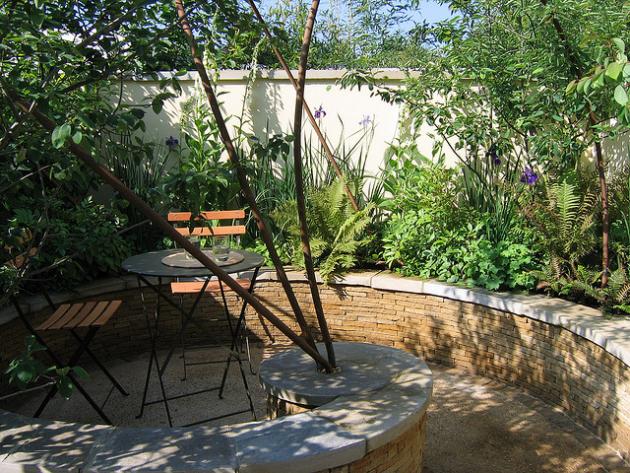Planting design is unique among the design fields because plants change over time. Not only do they change seasonally, but they grow, mature, and die like all living things.
The elements and principles used in planting design are the same whether the landscape design will be traditional or water wise.


The Basic Elements of Design
An element is a distinct unit that is a piece of a larger whole. The basic visual elements of any design include; line, plane, and volume. Other elements include color, shape/ form, space, texture, and light. These are sometimes referred to as characteristics of the basic elements of design.
Line
Lines can create movement and direction in the landscape. The shape of the line determines how this will happen. Straight, curved, zig zag, and spiral are some examples of types of lines that have different properties and can create a specific ‘feeling’ or mood in the space. Lines also help define edges.
Plane
A plane has the two dimensions of length and width. Planes have a variety of characteristics. They can be solid or implied. An example of an implied line are street tree plantings. Fences, walls, trellises, and repetition of plants in a line are also examples of planes.
Volume
A volume is simply a series of planes put together. It has length, width, and height. Volume is important in understanding how to create spaces in the landscape. Volumes can be enclosed or open. The biggest mistake beginning designers often make is to see the objects in the space as separate from the space itself. It is the space that we occupy.
Principles of Design
Principles are a set of rules or instructions on how to put together the elements to create an aesthetically pleasing landscape.
- Unity is the overarching principle of the entire design. Is there a sense of harmony or wholeness to the design?
- Variety – Add some variety to create interest
- Dominance or emphasis (focal point) gives a sense of visual impact to an object or group of objects
- Contrast (positive and negative) helps to differentiate different elements or objects in the landscape and create visual excitement
- Balance – both sides of the design feel visually balanced. Balance can be created through either symmetrical or asymmetrical alignment
- Rhythm creates a sense of visual and physical movement throughout space – Rhythm can be created using repetition
- Scale and Proportion – Appropriate size relative to other objects
- Repetition, continuation, and proximity of an element or elements can be used to create unity
- Simplicity!
More detailed information about the principles of design can be found in the following links.
Basic Principles of Landscape Design
Starting your Landscape Design
What are Water-Conserving Principles of Design?
Water conservation principles of design include the traditional elements and principles of design as part of the first step in the design process but go a step further to consider additional elements. The additional elements include, efficient irrigation, appropriate plant selection, soils, turf, mulch, and maintenance.
Additional Resources:
Southeast
North Carolina – Water-Wise Gardening
Florida – Resource Efficient Landscapes and Irrigation
Florida-friendly Landscaping
Southwest
Texas – Earth-Kind Landscaping
